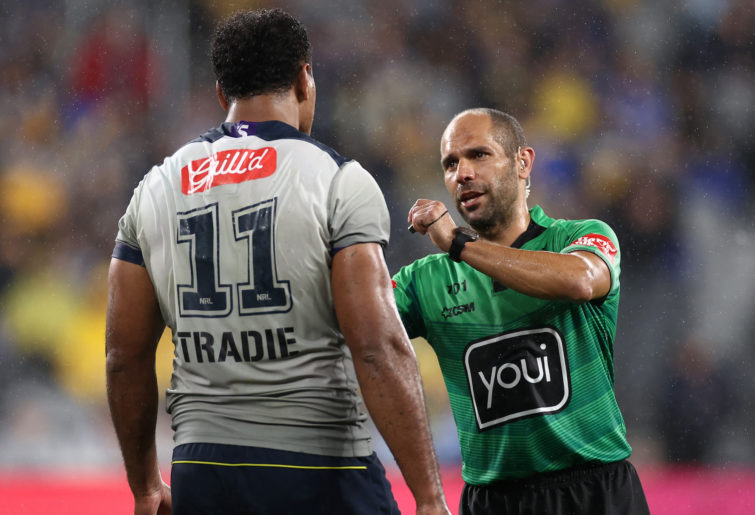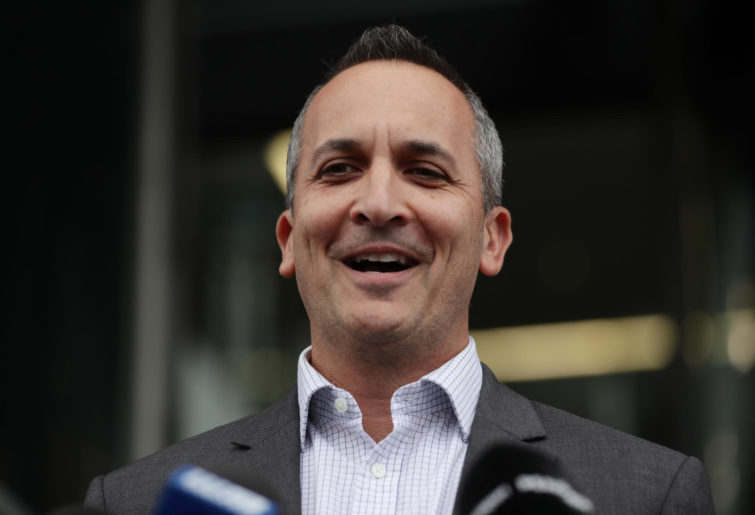There are two ways of interpreting last week’s announcement that the NRL are setting up a “multi-faceted review” to look into aspects of player safety, including stiffening up penalties for foul play.
One is that the NRL has a genuine desire to bring rugby league into line with modern standards and expectations with respect to on-field behaviour, in the process address the threat to the game that is concussion.
Another view might be that beneath the announcement lies a subtext of misdirection, prevarication and – for the cynics – a ‘bait and switch’ tactic, whereby the NRL might be seen to be acting on concussion while not actually fixing the issue at all.
This is, after all, a path that has been trodden before.
In the early 1980s, ‘Gentleman’ Jim Comans made a name for himself as a crusader cleaning the game up, including dishing out a record 15-month suspension to Western Suburbs’ Bob Cooper.
Comans left his role in 1986 with rugby league unquestionably made better for his dogged determination, and ugly ‘dockyard brawls’ being made a thing of the past. Yet somehow, standards were gradually allowed to slip.
In recent years, emphasis has shifted from the pure aesthetic to a wider understanding that concussion equals brain damage, which equals early-onset dementia, which equals retired players not being able to recognise their children and grandchildren. Or, in the well-publicised cases of ex-AFL players Shane Tuck and Danny Frawley, taking their own lives and a subsequent CTE diagnosis.
It’s serious business, made more so by mounting medical evidence that concussions are not only incurred in one-off trauma incidents, but via an accumulation of a series of seemingly minor ‘sub-concussive hits’.
In the case of the latter, that’s a matter for rugby league – and all collision sports – to continue to deal with as more detailed information comes to light. There are implications around the age at which contact sport should begin, the minimisation of contact at training, tackling coaching methods, and the length of time affected players should sit out before resuming physical activity.
For now, the low hanging fruit is ridding the game of avoidable injuries; many caused by reckless, often intentional foul play, where the NRL’s own rules prohibiting contact to the head are too often ignored by players, coaches and referees, and are not enforced by the judiciary.
There is a sense, this time around, of the drums beating more loudly. Australian rules football is awash with concern about concussion, with a raft of players lined up to lodge a class action against the AFL, and the AFL crudely trying to deal itself into the coronial inquest into Tuck’s death as a damage limitation exercise.
In such an environment it is fanciful that the NRL can continue to remain hidden in the shadows, particularly when players like Jesse Ramien, Jared Waerea-Hargreaves, Felise Kaufusi, Dallin Watene-Zelesniak, Sean Keppie, Daniel Suluka-Fifita and others appear not to have got the memo to stop hitting opponents in the head.

Ashley Klein puts Felise Kaufusi on report. (Photo by Cameron Spencer/Getty Images)
Recent history is informative. In March 2015, SBS reported that “the NRL’s concussion crackdown will go up a level”, with head of football Todd Greenberg indicating that while he was pleased with the results of newly implemented initiatives, more work had to be done to change the culture within the game.
One mechanism to effect that culture change was to clampdown on clubs who were breaching concussion protocols by allowing players to return to the field despite having suffered concussion. In March 2017, St George Illawarra, Newcastle and Gold Coast were fined a cumulative $350,000 in what then-CEO Greenberg said were, “by far, the heaviest fines ever proposed by the game for concussion breaches”.
As if to illustrate the point, Greenberg said, “that is how seriously we take it”.
So seriously, that after the inevitable squealing, $200,000 of the fines were suspended.
So seriously, that in April the following year, despite a sharply eloquent column by The Roar’s Tim Gore imploring Greenberg to continue with the clampdown, the NRL stopped reporting which clubs had breached concussion guidelines and what penalties had been applied.
Fast forward to September 2020, when ARLC chairman Peter V’landys and new CEO Andrew Abdo heralded Abdo’s appointment by reiterating that they would “find ways to take action and better protect players.”
Yet in November, Roosters and NSW player Boyd Cordner was allowed to return to the field in the first State of Origin match, despite Cordner being obviously concussed on-field. This despite Cordner having a history of having suffered heavy concussions. All of this coming just a few weeks after Cordner’s cousin, Joel Dark, passed away as a result of a head injury suffered in a NSWRL club match in Newcastle.
The NRL’s ‘action’? To send the NSWRL a ‘please explain’ letter asking why Cordner was allowed to return to play, and subsequently issuing them with a warning.

Boyd Cordner. (Photo by Mark Kolbe/Getty Images)
Into 2021, with respect to concussion, the season hasn’t started well. But if one incident can be singled out, it is Melbourne Storm player Felise Kaufusi striking Parramatta’s Ryan Matterson that may have tipped the balance.
This is partly because Matterson – a player who in 2018, following a head knock, admitted to sleeping up to 16 hours a day while suffering from light and noise sensitivity – receiving Kaufusi’s forceful elbow to the head and having his head slammed into the turf was an undeniably ugly sight. And partly because Kaufusi wasn’t sent off for his actions and, at the hands of the judicial system, suffered a piddling two-week suspension for his trouble.
Asked why Kaufusi wasn’t at least sent to the sin bin, the NRL’s head of football elite competitions, Graham Annesley, told reporters “They (the match officials) had to make a call in the heat of the moment. It could have gone either way. I’m okay they didn’t, and I would have been okay if they did.”
Not exactly the words of an organisation intent on better protecting players.
Yet three days later, in announcing the review, Abdo said the following.
“It is a brutal game but whenever you see acts of physicality that are not in the spirit of the game and can cause significant damage to the player and potentially were negligent or intentional, we need to make sure that there’s enough deterrents and consequences for players who do that.”
Confused? Anyone would be excused for not knowing that Abdo and Annesley are senior executives of the same organisation.
There are two ways this can go. Genuinely meaning what he says, Abdo will assert himself as CEO and drive permanent change in the sport, that will see the welfare of players take precedence.
Or Abdo’s words will go the same way as Greenberg’s, lasting for however long it takes for the pressure from media commentators, fans and coaches – unwilling or unable to grasp the health, legal and financial implications of continuing to ignore or pay lip service to the issue of concussion – to render them just that: words.

Andrew Abdo. (Photo by Mark Metcalfe/Getty Images)
This is the heart of rugby league’s looming culture war, a battle for control of the way the game is played. A raft of media commentators and ex-players on one side, determined not to see a tough man’s game watered down, against a bunch of doctors and so-called do-gooders and bed-wetters on the other.
In between lies a massive fan-base; one that may have been skewed heavily to the side of the big-hit merchants in the past, but which now seems to be more attuned to the concussion issue than the game’s administrators might believe.
You can’t fake this stuff; you either believe or you don’t believe. Annesley’s authentic reaction demonstrated he was okay with Kaufusi not even being sin-binned. That person is not the person who wakes up the next morning primed to eliminate forceful head-high contact from the game.
Time will tell if concussion is an issue Abdo is prepared to die at the stake for. But if real change is to occur, it will require not just Abdo, but a powerful advocate in the game – a high profile ex-player with a prominent media presence – to carry it.
There is no evidence so far to suggest that such a person exists. Most of the candidates are compromised through their employment with Nine, News Corp or the NRL.
Also, if panel and newspaper discussion this week is anything to go by, there seems to be a belief that ‘cracking down’ by sending more players to the sin bin has already fixed the concussion issue. It hasn’t.
Watch for those same people to preface comments with, “The safety of the players is paramount,” before arcing up at players sin-binned and reported for head contact they don’t rate sufficient forceful to warrant sanction.
Never mind that the science is in; any hit to the head is dangerous.

(Photo by Cameron Spencer/Getty Images)
Another group who can’t be relied upon to drive culture change are the players. In the wake of three rounds worth of injury carnage – including numerous concussions, RLPA president Clint Newton and others rushed to demand that the NRL alter the rules to allow an extra concussion substitute on the bench.
That’s right; faced with increasing numbers of head injuries, the players, instead of asking for a summit or a detailed study into why those injuries are occurring and what can be done about minimising them, have instead asked for more players to be added on match day, to replace the fallen ones.
Newton is a genuine individual and a passionate advocate for players. Yet the RLPA has advised The Roar that it is satisfied that the NRL is dealing with concussion in a way that appropriately addresses the concerns of its members.
It is hard to reconcile those two statements.
It seems like rugby league players are like beached whales. It’s difficult to save people who don’t want to be saved, particularly when preserving the integrity of the contest, 13 versus 13, is paramount.
It is important to note that not all head injuries occur as a result of foul play. Cade Cust, Reuben Cotter and Mitch Moses are among the players in the last fortnight who have got themselves into awful positions in attempting tackles and knocked themselves out.
These cases are merely another reason why the NRL should call a summit that examines all reasons for concussions, and with the help of medical professionals and coaches, looks at what actions can be undertaken to minimise incidences, whatever the cause, and looks at changing the understanding and messaging around concussion.
Until that happens, and until concussion-inducing foul play like that of Kaufusi is met with sanctions appropriate enough to deter others, expect only to hear more rhetoric from people in the game about how ‘seriously’ the issue is being managed.
The ball is in Abdo’s court. He can choose to perpetuate that myth, or he can choose to launch a culture war and take on the concussion scourge for real.
































































































